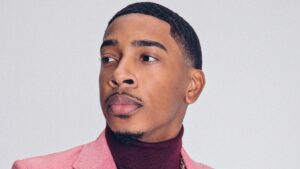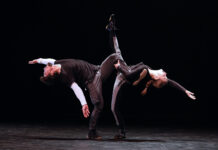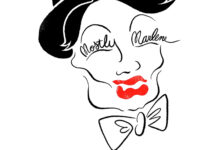The Monterey Jazz Festival was introduced to the world on October 3, 1958. When this year’s festival takes place it will mark their 65th year. But not everyone can make it to Monterey. So they put the Monterey Jazz Festival on Tour. This year’s edition has just launched with a line-up featuring Dee Dee Bridgewater and Kurt Elling on vocals. Joining them are alto saxophonist Lakecia Benjamin, bass player Yasushi Nakamura and Clarence Penn on drums. Pianist and composer Christian Sands serves as music director. (For the full itinerary see the end of this interview.)
Sands is a two-time Grammy nominee: Best Jazz Album for his work on Christian McBride’s Out Here in 2013 and for Best Instrumental Composition for Be Water II from his 2020 album Be Water. He’s been recording his own albums since 2002’s Footprints. Sands is considered one of the finest musicians of his generation.
We spoke with him about collaborating with Bridgewater and Elling; his view of music’s ability to bridge divides and what it takes to bring an audience with an artist. What follows are excerpts from our conversation that have been edited for length and clarity. To see the full interview, please go to our YouTube channel.
I want to ask you about something you posted on your Facebook account in August. It was a quote by Langston Hughes. “An artist must be free to choose what he does. Certainly, but he must also never be afraid to do what he might choose.” How does that thought process serve as a guiding principle for you? And if it does, how does that inspire the choices you make, both in the short term and the long term for you as a person and as a musician?

Well, it really speaks into just the reflection of who you are as an individual and just being secure in your decisions and your creative process and being truly who you are. For myself it’s been a journey discovering that. For everyone, you know, but me as a creative it’s something where you believe one thing and then all of sudden, maybe something in your life or some event or something you’ve come across changes that or shifts that. So now you have to discover what does that mean.
How do I take in this information? How do I use this? Is this information usable? It’s that way with music, it’s that way with life, it’s that way with anything; relationships, with people, as a performer with people that you meet, audience members or band members. Life takes you on a different journey. So what I try to do is to just say, “Hey, okay, this is an obstacle and this is a challenge and let’s rise to the occasion and see if we can do it.” You know sometimes you’ll be surprised that you actually will rise even higher than you thought you would.
As part of the Monterey Jazz Festival on tour you get to work with Dee Dee Bridgewater and Kurt Elling, who I think we can safely say are standard bearers of heavily-rooted jazz traditions in what they do. What is the dialogue you hope to create with them between their traditions and the direction you would like to see music go?
We’re all friends. I’ve known them for quite some time. I look up to them as mentors. I’ve looked up to them as leaders in this music – people that have paved the way for the generations after them to present and express themselves the way they do. With that being said, it’s an honor to be making music with them and to be the musical director for them. And it’s a lot of fun because they’re very vocal, they’re very animated, they’re very charismatic and they’re very involved. Which is wonderful because they will let me know things that they want to try.
The great thing about working with Dee Dee and Kurt is that they are so open to trying new things. If anything, more new things than what I feel maybe some audience members are comfortable with. Which is an amazing thing because me, being in a different generation, I can push and pull and challenge them in a way. They are more than happy to do so. So it’s actually a really fun environment to work in and to just collaborate with these two artists is really incredible.
What is an example of something that Dee Dee might want to do that would be outside the comfort zone of what people might expect her to do?
If I say to Dee Dee I’m thinking about doing this Jefferson Airplane thing, she’s like, absolutely cool, you know? Or if I say to Kurt I’m thinking about doing this Brian McKnight thing, you know, like I heard this and I want to kind of do an arrangement of it. He’s like, absolutely, let’s try that. Let’s check it out and see what we can do.
How do the six of you choose what’s going to be the right vibe for each evening’s show?
Being the musical director it is my job and my duty to try to figure this out. It is such a wonderful challenge to have. When you’re dealing with these amazing artists on stage who have these different ways of expression, really the music can go anywhere. So you will hear some standards. You will hear some original compositions. We’re representing the Monterey Jazz Festival, so we will be paying homage to the past and we will be reinventing or re-imagining some songs that may have been performed at the festivals. Music by Dave Brubeck, Sonny Rollins, Dizzy Gillespie, Billie Holiday. So we do have that. Then also we have our own stuff as well that we’re working out. So I am up to my neck in possibilities. Just in case the crowd shifts, I could say, let’s play this or let’s do this. Or let’s feature Lakecia and Yasushi on this. So there’s different ways to skin a cat, as they say.
You’ve studied with with Jason Moran and you also studied with Dr. Billy Taylor and Vijay Iyer. A trio of musicians who all have enormous similarities and equally enormous differences, both in terms of how they play and how they look at music. How do you feel your learning from them is exhibited through the work you now do as a musician?
With Dr. Billy Taylor’s business, you know, I’ve learned a lot from him on the business side of it. Just being an artist and being in meetings, being in the boardroom, curating different things. You know, the wonderful thing about Vijay, Jason and myself, we’re all products of Dr. Taylor. [He] was the one that came before us that really established the groundwork on what we do as pianists, as composers, as arrangers, as people that curate music and bring music into a place that may not have anything that exists there.
Studying with Jason Moran, pianistically it was still steeped in the tradition. It was just a different version of it. What he brings to it is visual art. And he brings very different, I won’t even say different, it’s just the other hand, you know. If you have the right hand, it’s just the left hand. That’s it. It’s a beautiful complement to that.
Vijay Iyer is also sort of in the middle of that. I’ve also had teachers like Dave Brubeck, like Geri Allen as well. They all have shaped how I interpret, how I present the music, how I talk about the music, how I feel about the music, the possibilities that you could have. The great thing about Jason Moran is Jason lets you know that the possibilities with music are something that’s malleable and have no limit. You can put it in any space. You can bring it anywhere. You can touch it if you want to. You can smell it. You can taste it.
All these these geniuses have brought a certain way of presenting the music and also are just absolutely amazing. They’re all steeped in the history. When you think of Jason Moran, you think of Thelonious Monk. When you think of Geri Allen, you think of Herbie Hancock, you think of Bud Powell. When you think of Dr. Billy Taylor, you think of Art Tatum, you think of Earl Hines, you think of Erroll Garner. When you think of Count Basie, you think of Fats Waller. So there’s all these people that come through Duke Ellington and so now we get to me. So hopefully you think of all these people when you hear me. All of my influences, all the people that I love, all the people that I admire, all the people I respect as well.
What do you think of when you think of your music?
I just think of me. That’s the honest answer. I think of just what I’ve been through in my life and where I would like to go. So that’s my music. So any time you listen to me you’re hearing me.
You’ve talked on multiple occasions about Dr. Taylor telling you that one of your jobs is about bringing the audience along with you. What are the challenges that you and any other jazz musician faces in accomplishing that? What do you think is the best way to realize that advice he gave you?
I think it’s something that you have to have patience and awareness to do. Some some artists don’t care, right? Some artists like I play what I play and it is what it is. And you like it or you don’t, you know? I want to bring you into the fold. So this is how we do that. I think there’s different versions of it. With Dr. Taylor I would watch him, before playing a song, talk about what you were going to hear. He would literally break it down for you. Then you get some people that don’t say anything and just play – which is also an experience in itself as well. So it really depends on how you want to present the music. I do a little bit of both. Sometimes I feel like talking and sometimes I don’t. Sometimes I’ll tell the audience I’m not going to tell you what I’m going to play. You’re just going to have to be open and listen to it and see what you think because I know you’re going to like it.
It’s been a couple of years since you’ve had a new album out. You posted on January 1st on your Instagram account that it was time to start new work. What can we look forward to after this tour?
There’s a lot of new music I’ve been writing. I’m working on a couple different projects. So be on the lookout for good things. I have a couple of albums that I’m trying to do this year – so you might get more than one which will be a lot of fun. It’s a lot of work, but I’m excited. I’m inspired. Now I live in Los Angeles, so there’s new experiences and new new feelings and new things to write about. So I’m looking forward to presenting my findings and my experiences and just having a ball creating.
I know one of your passions is photography. How does photography find its way into your music and perhaps how does your music might find its way into your photography?

It’s a little bit of both. With photography what I love about it is the discovery of composition; looking for different different angles to look at something. It all depends on what you’re really looking for out of that subject. That’s the same thing with the music, whether it’s an original composition or a song that’s been done countless times. That’s the subject, but how do we make this unique? What are the angles that I need? What is the lighting that I need? What is the the shading?
When I say lighting and shading, I’m talking about harmony, I’m talking about rhythm. How do I approach this to make it my own? How much do I need? Why does this mean something to me? Trying to understand that.
I also cook as well. So it’s also doing that in the kitchen. Everything kind of goes hand in hand from cooking. What spices do I need? How do I season this? How do I sear this? How do I do this to create this thing? Then the end result is this great meal. The end result is this great song. The end result is this great photo.
In an interview you did in 2017 with Ralph A. Miriello you were talking about how you wanted “to represent America and where I am from.” Where do you see America as we start 2023? How does that influence how you want to express yourself?
As always, there’s a lot to do in America. But I believe that we have the capability to do all of it. If anything, music and art have taught us that we all have compassion and we are looking for the same things. We all are trying to reach for the same goals. We are all trying to come together as one. We do need to remember to do that. I do believe that there is potential and I do believe that there is a way of coming together to resolve some of the issues that we have.
There’s also some things that are very sensitive that we have to understand. These are different times. I believe that with communication, trust and love, that anything can be accomplished. That’s what I’m looking forward to for the rest of the year. And I believe that we will be able to reflect that in the art that we create.
In Hazrat Inayat Khan’s Mysticism of Sound & Music, a book I know you love, there is a line that you’ve highlighted on social media, “The more one studies the harmony of music, and then studies human nature – how people agree and how they disagree, how there is attraction and repulsion – the more one sees that it is all music.” What role can and should music play in getting us to a place where that line can serve as inspiration for finding our commonality in spite of divergent perspectives on the world we live in?
I believe music, it always does that. Music has never not been the bridge between things that went unsaid. Music has always been that instrument that when there are no words and there’s no way to express, we do it this way. We do it through music. We do it through art. We do it through film. We do it through painting, drawing. We do it through photography. We do it through different mediums. But with music I believe it’s one of the most important ways of expressing yourself because it really allows you to fully understand in a sound what is happening. You can resolve anything with music, you can resolve complications, but you have to be open to what that resolve is going to be. You can always do it within music. I believe music is the bridge between it all.
As long as whoever is hearing it is willing to actually listen.
Absolutely. Absolutely.
To see the full interview with Christian Sands, please go here.
Monterey Jazz Festival on Tour itinerary: January 19th: McCallum Theatre in Palm Springs; January 20th: Walt Disney Concert Hall in Los Angeles; January 21st: Fox Tuscon Theatre in Tucson; January 23rd: Capitol Theatre in Salt Lake City; January 25th: Segerstrom Center for the Arts in Costa Mesa, CA; January 26th: Balboa Theatre in San Diego; January 27th: Gallo Center for the Arts in Modesto, CA; January 29th: Campbell Hall at UCSB in Santa Barbara. There’s a second leg of the tour beginning on April 6th in Hartford, CT and continuing through April 23rd in Detroit. For that itinerary, please go here.
Main Photo: Christian Sands (Photo by Anna Webber/Courtesy Music Works International)











